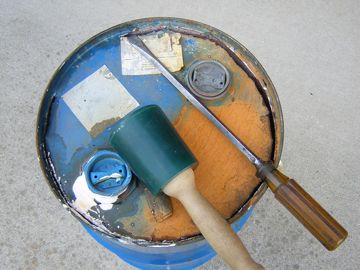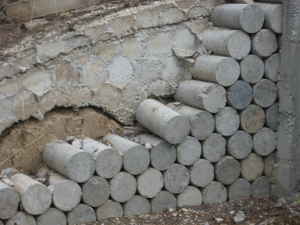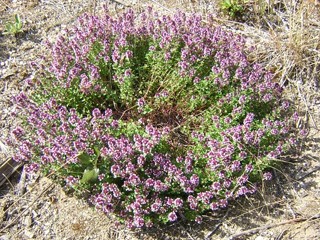Landblog Main
previous archive
Barrels -- 7 July 09 -- Of all the free stuff I thought I was going to pick up with the truck, barrels have turned out to be the easiest. But nobody ever gives away a clean barrel with a removable lid, at least not to a stranger. The first one I got, a 55 gallon drum from Freecycle, was rusty and totally sealed except for a little spout that I used to drain the four gallons of dirty gasoline that were still inside. Then I found two more on Craigslist, one 55 gallons, with an open top and no lid, and some kind of water soluble black goop in the bottom, and the other 20 gallons, with a sealed lid and a congealed mass of white paint in the bottom. I wasn't sure how I was going to open the sealed ones. My first idea was to ask my brother-in-law to bring his Sawzall when he visits in August, and I even bought a $3 blade for it. But that would require me to keep ugly barrels around the housesit, and also to haul the first one back from the land, which doesn't have electricity. So I wondered how hard it would be to just spend a couple hours sawing around the edge of the lid with the blade in my hand. First I would have to make a gap to get the blade in, so I got the biggest screwdriver I could find and pounded it through with a mallet.
I wasn't sure how I was going to open the sealed ones. My first idea was to ask my brother-in-law to bring his Sawzall when he visits in August, and I even bought a $3 blade for it. But that would require me to keep ugly barrels around the housesit, and also to haul the first one back from the land, which doesn't have electricity. So I wondered how hard it would be to just spend a couple hours sawing around the edge of the lid with the blade in my hand. First I would have to make a gap to get the blade in, so I got the biggest screwdriver I could find and pounded it through with a mallet.Then I thought, suppose I just keep going like this? As you can see from the photo, it worked. After a few inches I began figuring out out how to angle the screwdriver so I could pound it continuously. (The photo does not illustrate that angle!) I had to take some breaks, and also get earplugs because it makes a terrible clanging noise. But the entire job took less than 15 minutes of hammering. That's a Wood Is Good mallet, which I recommend.
Update: I wondered if someone had already invented a tool like a giant can opener for barrels. They have: it's called a drum deheader, and the different models run anywhere from $20-400.
 Roofing -- 20 July 09 -- This is seven sheets of roofing, 40 inches by 10 feet, plus an extra that's 40 inches by 8 feet. I just bought it from a guy on Craigslist who called it "9+ sheets HEAVY gauge corrugated metal roofing 4'x10' no holes $18ea". I was really looking for something like this, and apparently I'm not alone, because here's a site selling new rusty metal roofing for $140-200 per 100 square feet.
Roofing -- 20 July 09 -- This is seven sheets of roofing, 40 inches by 10 feet, plus an extra that's 40 inches by 8 feet. I just bought it from a guy on Craigslist who called it "9+ sheets HEAVY gauge corrugated metal roofing 4'x10' no holes $18ea". I was really looking for something like this, and apparently I'm not alone, because here's a site selling new rusty metal roofing for $140-200 per 100 square feet.I told the guy, honestly, that it wasn't what I was looking for, which probably lowered the price, and then I decided to buy it anyway, and he accepted my offer of $100 for the lot. I've just calculated the surface area at (40/12)x(7x10 + 8) = 260 square feet. I didn't even know until I got back whether it was steel or aluminum, but a refrigerator magnet identifies it as steel. Then I managed to measure the thickness with a crescent wrench and a feeler gauge, at roughly 0.025 inches, and looked up some charts to find out that it must be 0.0239, or 24 gauge. 24 gauge is technically "heavy", but not "HEAVY" -- that would be 18 or 20 gauge. (Smaller numbers are thicker, and 20 gauge is 50% thicker than 24, which is 33% thicker than 26.)
I still have no idea if I got a good deal, but I know I got some metal roofing good enough to walk on and hold heavy snow.
July Wrapup -- 28 July 09 -- This month I've hauled up roofing and a bunch of broken concrete, and yesterday I cleared a ten foot circle just east of the fridge. In keeping with my new policy of not writing about any building-related tasks until after I do them, I have to say that I just like collecting materials and digging circles, and I'm not planning anything.
The three apple trees that got broken off at the base by snow last winter, which I thought were dead, are all resprouting vigorously. In fact, they've put on much more growth than the trees that were not broken. In three months the Ashmead's has grown six new stems as long as my forearm, while the Prairie Spy, originally the strongest tree, has only lengthened its stubby branches by a couple inches. So I'm seriously considering cutting them all off at the base, if the snow doesn't do it for me. Maybe in my particular climate the apple tree likes to grow as a bush.
Nothing I've planted this year has died yet, probably because I used more compost than in previous years, and because I've been watering more often, going up every five days during the most intense heat. Also, the two American chestnuts, which I gave up for dead, have both recovered and are growing well. And although the upper parts of the Arctic Jay nectarine and Chinese sweet pit apricot died last winter, both grafted rootstocks were still alive. I tossed the apricot rootstock, which I think was some kind of plum, but I may grow out the Lovell peach rootstock and see what kind of fruits it makes. And I'll try both plants again in different locations.
This year the blue honeysuckles (Lonicera caerulea var. edulis) have produced their first berries. They're the size of blueberries and look like this, but they don't taste nearly as good as the native black huckleberries. Also this year I got my first Bali cherry, and I'm very happy with the flavor, so I might plant one or two more.
I haven't seen any fresh moose sign this year, and Henry thinks someone shot the cinnamon bears. But a few weeks ago I saw my first buck. He was too young to have antlers, but I could immediately tell he was a male just from the way he moved. Does drift like clouds and bucks leap around like lightning.
Chainsaw -- 13 August 09 -- So on this trip I finally got around to using the Husqvarna 340 I bought almost five years ago. I've hesitated so long because I've known chainsaws to be noisy, vibrate a lot, spew awful fumes and splatter toxic oil, and I wasn't sure how much faster they would cut than a good crosscut saw. But this one has good vibration dampening, it's not noisy through the ear protection, and I've filled it with fully synthetic fuel and food-grade bar oil, so it's as clean as an internal combustion chainsaw can get. And even though it's relatively weak (41cc, 2.7 hp), it cuts damn fast! It went through a foot thick western hemlock log in about ten seconds.
On this trip my main project was to find and prepare three straight round beams, roughly five inches thick and exactly 142 inches long. I went up and poked around on the north hill, and picked out the straight parts of a couple fallen ponderosa pines, and cut down a third one that just died this year. I used the hand saw to cut it down, because I didn't want to deal with holding a running chainsaw and getting away from a falling tree at the same time. Ponderosa pine is not the strongest wood, but it does like to grow straight and round. All the other tree species up there, except maybe larch, have much more taper: so it would be hard to find a long piece where one end wasn't much thinner than the other.
I also dug four holes to plant pawpaws next spring. The name "pawpaw" is also used for papayas, but these are a north American fruit that supposedly tastes like a banana and can survive cold winters. They need shade when they're young and sunlight when they're fruiting, so I dug the holes north of trees that I plan to kill in a few years.
Also I cleared out a prime orchard area near the upper cherries, just downhill from the spring, with good morning light and shade in the hot afternoons. I want to transplant the black currants there from the south boundary where they're barely surviving, but currant bushes are short, so I should put something taller between them and the forest. Right now I'm leaning toward American Plum (Prunus americana). The fruits are smaller than European or Asian plums, but they taste just as good and they're much easier to grow.
And one great bit of plant news. The oldest of my black walnuts is still so small it's hard to find among the bracken ferns, but it is now established well enough that it has that wonderful black walnut smell. This has been a relatively wet summer, so I'm optimistic that the two I planted this year will also survive.
 Cylinders -- 20 August 09 -- These are concrete test cylinders. When professional builders are making something with concrete, they turn some of it into these, and then see how hard they are to smash. The photo comes from the Craigslist posting where I found them.
Cylinders -- 20 August 09 -- These are concrete test cylinders. When professional builders are making something with concrete, they turn some of it into these, and then see how hard they are to smash. The photo comes from the Craigslist posting where I found them.My new policy is not to write about any building-related task until after I've done it, so I'm not saying what I plan to use these for, just that they're absolutely perfect. Last night I did some math and figured out I needed 25 feet of width, and that I might be pushing the limit of my truck to haul that much in two loads. So this morning I removed the passenger seat, which reduced the weight by 40 pounds and made a spot up front to distribute the weight more evenly. Then I drove to pick them up in the foothills of Mount Spokane, at the top of many miles of steep winding gravel roads, on a 95 degree day.
It turns out they're 12 inches long, six inches in diameter, and 27 pounds. In two loads of 25 (675 pounds each), I hauled 50 of them up to the land. Total cost, via my ScanGauge II: $17.80 in gas money.
 Wild Thyme? -- 22 August 09 -- I noticed this tiny bush growing in one of the more desolate parts of the "parking lot" area, but didn't try to identify it until it burst out with pink flowers that attracted even more insects than the knapweed. I still don't know the latin name, but it tastes like oregano. [Update: I decided it has to be thyme, because thyme is taprooted and oregano is not, and only something with a very deep root could thrive in this location.]
Wild Thyme? -- 22 August 09 -- I noticed this tiny bush growing in one of the more desolate parts of the "parking lot" area, but didn't try to identify it until it burst out with pink flowers that attracted even more insects than the knapweed. I still don't know the latin name, but it tastes like oregano. [Update: I decided it has to be thyme, because thyme is taprooted and oregano is not, and only something with a very deep root could thrive in this location.] Underground House Complete -- 30 August 09 -- I'm joking. This is the intake for a greywater sump. Chuck came up from Portland this weekend and donated and mostly installed it. That elliptical shape around it, I'll explain another time.
Underground House Complete -- 30 August 09 -- I'm joking. This is the intake for a greywater sump. Chuck came up from Portland this weekend and donated and mostly installed it. That elliptical shape around it, I'll explain another time.I forgot to take pictures until the very end, but Chuck brought up a ten foot length of six inch plastic pipe, with three rows of quarter inch holes drilled all along the bottom. The end was plugged with a plastic grate, and the other end was attached to a 22½ degree elbow, which was attached, via another short bent connector, to the four foot vertical pipe. It's hard to explain without pictures: since you're unlikely to lay the horizontal pipe at an exact 22½ degree slope, the vertical pipe will be slanted downhill or more likely uphill. But the second bent connector allows you to rotate it, and turn the uphill slant into a sideways slant, which you can then correct by rotating the whole thing along the axis of the bottom pipe. Luckily I had a good level to get the pipe straight, and a mallet to attach and remove the bottom pipe a couple times before we got it right.
At the top of the vertical pipe are a couple stovepipe parts, and a screen made of quarter inch hardware cloth held on with a hose clamp. The pipe in the ground is buried almost two feet deep, and underneath it Chuck put five gallons of gravel. If I had to do it again I'd use ten or fifteen gallons, but five was all we had, and it should still work because the soil at that depth is almost pure sand. Then we put the silty upper soil back in the trench.
So now there's a safe way to get rid of greywater, and it will eventually make a nice place for a garden.